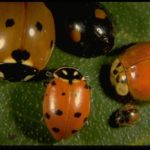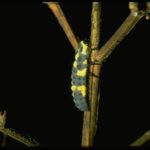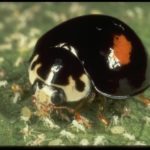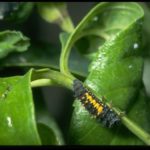Common Name: Lady beetle (“lady bug”)
Scientific Name: Varies
Order: Coleoptera
Description: Lady beetles are also called “ladybugs” or “lady bird beetles.” Adult beetle is orange with 6 small dark spots on each wing cover. The segment behind the head (pronotum) is black with a white margin and two convergent white dashes (appearing like \ / with the head at the top). The larva is soft-bodied, gray and orange markings, and covered with rows of raised black spots.
There are a number of naturally occurring and introduced lady beetle species (see Harmonia Lady Beetle). The spotted lady beetle, Coleomegilla maculata (DeGeer) is dark pink rather than orange-red, and has large black spots on the wing covers (elytra) and no white markings on the shield just behind the head (pronotum). Other commonly occurring lady beetles include the twice-stabbed lady beetles, Chilocorus cacti (Linnaeus) and Olla v-nigrum (Mulsant).These species are all black except for two red spots on the elytra. The twice-stabbed form of Olla has white markings on the side of the pronotum. C. cacti feeds predominantly on scale insects. One of the smaller lady beetle species is Scymnus loewii Mulsant, being only 1/16 inch long. Adult beetles are dull orange on the sides with a black “V” on the wing covers. Larvae of this species, which feed on aphids and mites, and secrete wax filaments on their bodies which make them look much like mealybugs.
Life Cycle: Fed female adult beetles lay yellow oval-shaped eggs in clusters or singly near infestations of aphids or other pests. Larvae hatch from eggs and develop through several molts (instars) until they pupate. Development from egg to adult takes 2 to 3 weeks.
Habitat and Food Source(s): Mouthparts are for chewing. Larvae and adults feed primarily on aphids, but they will also feed on scales, eggs of caterpillars and other soft-bodied insects and mites. Adults occasionally feed on nectar, pollen and honeydew (exudate of aphids and other sucking insects). Adults disperse seeking feeding and reproduction sites.
Pest Status: Beneficial; natural enemy; predaceous adults and larvae; medically harmless.
Management: None, this is a beneficial insect.
For additional information, contact your local Texas A&M AgriLife Extension Service agent or search for other state Extension offices.
- Lady beetles, (Coleoptera: Coccinellidae). Photo by Drees.
- Convergent lady beetle, Hippodamia convergens Guerin-Meneville (Coleoptera: Coccinellidae), larva. Photo by Barr.
- An ash gray lady beetle, Olla sp. (Coleoptera: Coccinellidae), two-spotted color form, adult feeding on aphid. Photo by W. Sterling.
- Multi-colored Asian lady beetle, Harmonia axyridis (Pallas) (Coleoptera: Coccinellidae), larva. Photo by Drees.
Literature: Frank & Slosser 1991. Henn & Weinzieri 1990.



